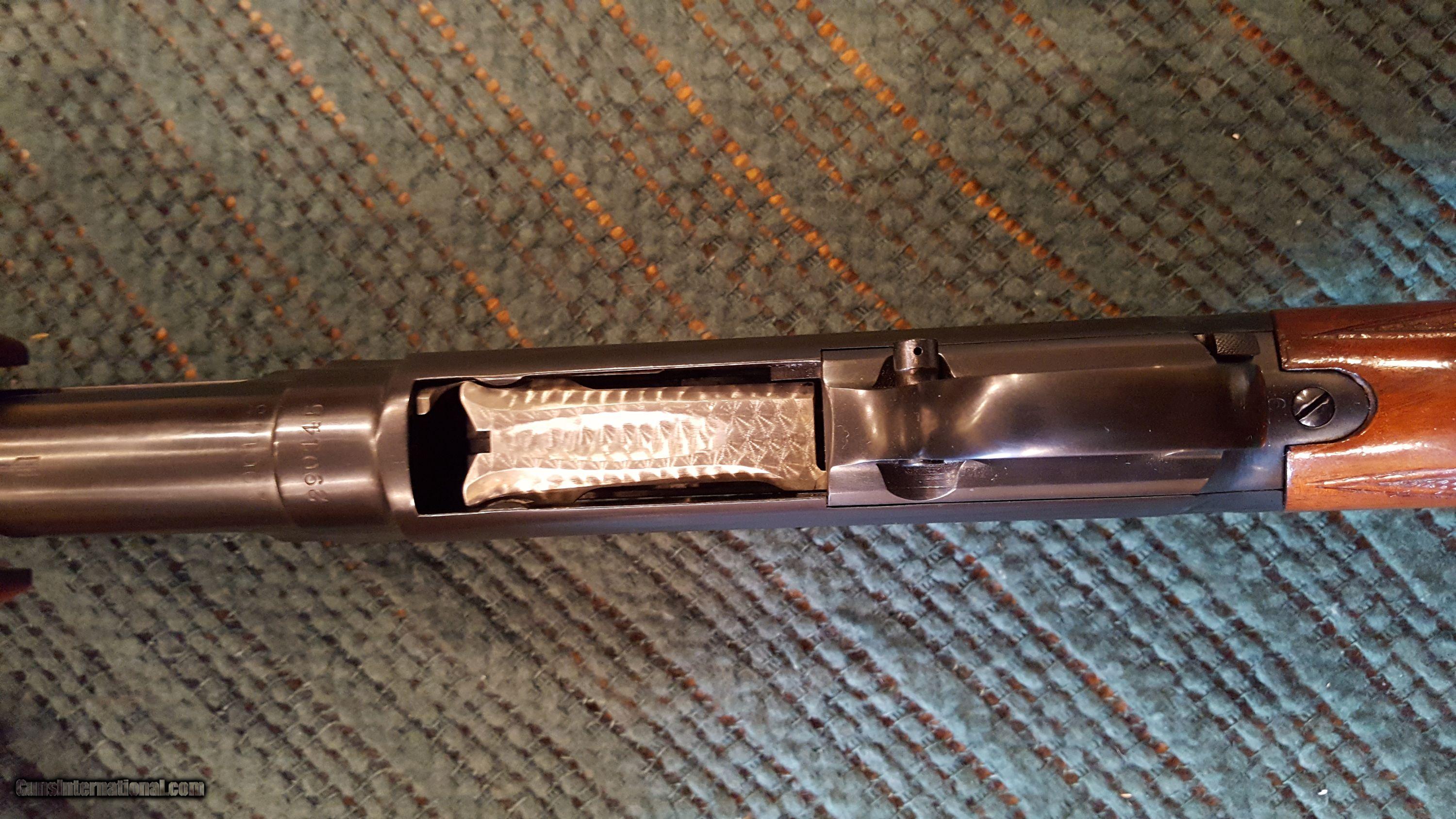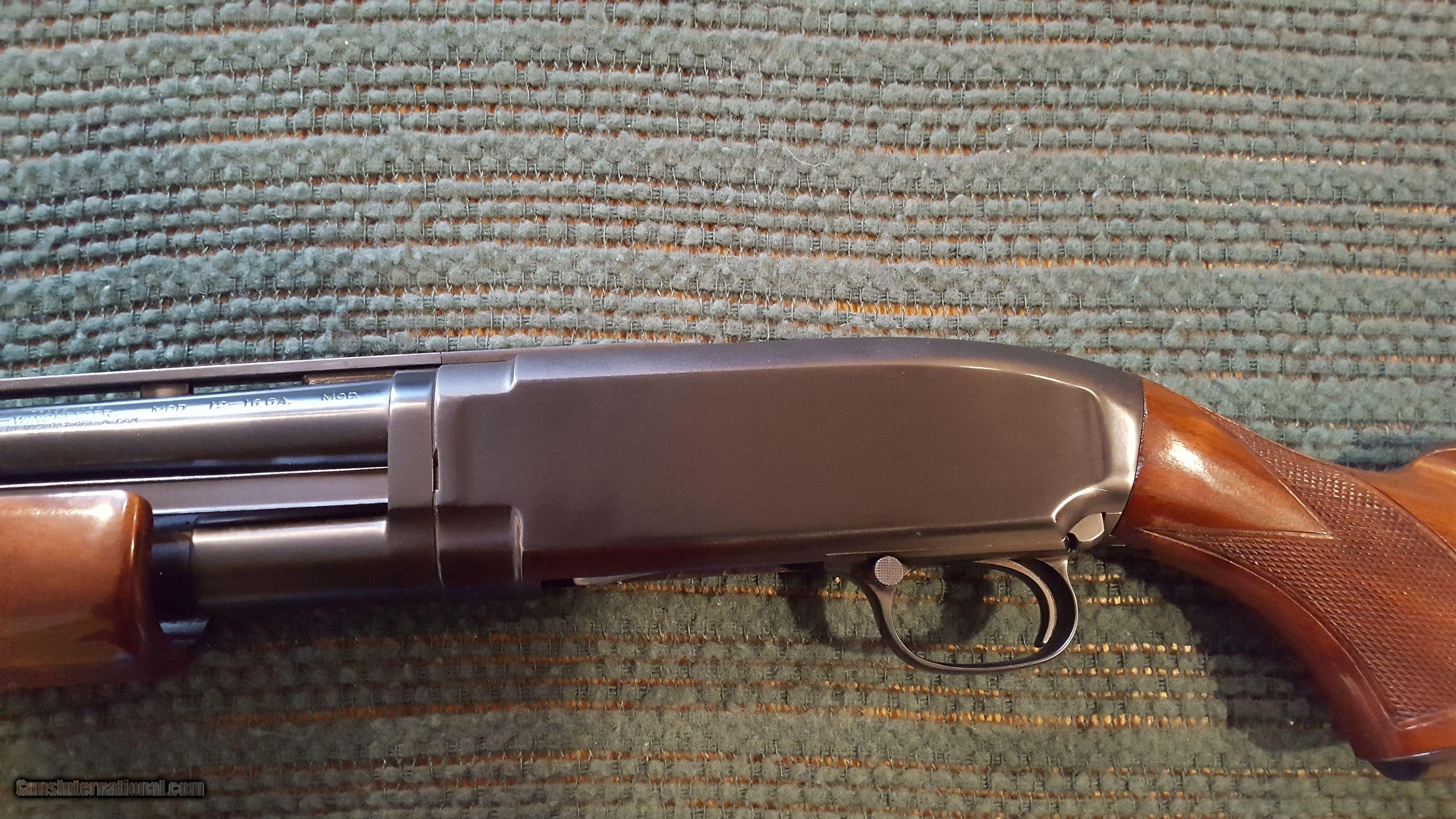
Winchester Model 12: The Perfect Repeater By Chuck Hawks 12 gauge Winchester Model 12, manufactured in 1948. Photo courtesy of Wikipedia Commons. The famous Winchester Model 1912 pump shotgun was designed by Winchester's Thomas C. Introduced in 20 gauge in 1912, 16 and 12 gauge guns followed in 1914. From its debut until the end of the 1950's, the Winchester Model 1912 was the pump shotgun, long known as 'the perfect repeater.' After 1919, the model designation was shortened to 'Model 12,' but the gun remained the same. Oh, sure, Ithaca, Stevens and Remington guns had their fans, but it was Winchester's Model 12 that dominated both the market and the public consciousness for decades.
However, by the beginning of the 1960's, the times were a changin', to paraphrase Bob Dylan. In the case of the firearms industry, the biggest change was necessitated by skyrocketing labor costs that rendered many of the best production firearms unprofitable, a regrettable process that continues to this day.
Well, here is a listing of our Winchester Rifle and Shotgun Owner's Manuals. Feel free to browse through any of them by clicking on the one that interests you. If you don't find your manual in our listing or need a printed one, don't despair.
Guns designed for less labor intensive manufacture, using stamped sheet metal parts, cast aluminum frames and impressed checkering were the coming thing in the late 1950's and early 1960's, necessary to hold retail prices in check. Winchester succumbed to the pressure of rising costs in 1964 by introducing complete revisions of their most popular centerfire rifles (the Model 70 and Model 94) and introducing entirely new rimfire rifles, pump and autoloading shotguns designed specifically to reduce production costs and increase profit margin. Perhaps the most dramatic change in 1964 was the new Model 1200 pump shotgun, which replaced the classic Model 12. The Model 1200 shared almost nothing with its Model 12 predecessor, except the first two digits of its model number and a streamlined action.
The new Model 1200 was built on an aluminum receiver, instead of the Model 12's machined steel receiver. The Model 1200's rotary locking bolt design owed nothing to the previous Model 12 action and the new gun was cheapened in every way.
Anatomy and physiology martin study guide. Start studying Human Anatomy and Physiology Test 2 (Martin). Learn vocabulary, terms, and more with flashcards, games, and other study tools. Learn lecture exam 1 anatomy physiology martin's with free interactive flashcards. Choose from 500 different sets of lecture exam 1 anatomy physiology martin's.
Internal parts were stamped from sheet metal, instead of machined from steel forgings. The walnut stock and forend had their checkering stamped in reverse by heat and pressure, a process pioneered by Remington. The Model 1200 was intended to compete on even footing with the Remington Model 870 pump gun, which had pioneered most of the same production shortcuts. Remington, however, had wisely retained a machined steel receiver for their Model 870. Thus, while the 870 could not match the internal quality of the old Model 12, from the outside it looked like a higher quality gun than the new Winchester Model 1200.
16 Gauge Model 12 Winchester
In 1964, Model 12 production was ramped down in favor of the new Model 1200 pump gun and Model 12 prices were allowed to soar. The Model 12 became a limited production gun and Model 12's were not mass produced after 1963. Model 12's produced from 1964 onward have a 'Y' prefix added to their serial numbers. Post-'64 Model 12's were offered in Field, Super Pigeon, Skeet and Trap grades.

All had hand checkered, select walnut stocks and jeweled bolts. Super Pigeon guns were available only through the Winchester Custom Shop All Super Pigeon guns were engraved, as were some Field, Trap and Skeet grade guns. All Model 12 production finally ceased in 1980. High grade Limited Edition Model 12 and Model 42 shotguns were subsequently offered by USRAC from 1993 to 1995; these were made by Miroku in Japan. Unlike the Model 12, none of Winchester's post-'64 new models has withstood the test of time. Strangely, perhaps due to Winchester's long established reputation for building top quality guns, the shooting public in 1964 would not accept production shortcuts in Winchester firearms that they took for granted in Remington, Savage and Mossberg guns.
The post-'64 Winchesters were never accepted by most knowledgeable shooters and this ultimately contributed to the downfall of Winchester Repeating Arms. Fortunately for discerning shooters, the resurrected Winchester Repeating Arms Company-now owned by the Walloon, Belgium group-is once again producing top quality firearms, including what are arguably the best Model 70 and Model 94 rifles ever made and a reborn Model 101 O/U shotgun. Winchester even has a new pump shotgun, the hideously ugly Super-X Pump that uses a rotary locking bolt action reminiscent of the post-64 Model 1200.
Today, after decades of dumbing down consumer standards and expectations, aluminum receivers, MIM and stamped sheet metal parts, plastic trigger guards and plastic stocks have become the norm. The Super-X Pump makes the much maligned Model 1200 of 1964 look like a deluxe shotgun, so far have consumer standards fallen since 1964. However, I digress; back to the Model 12 story. Among the key features that made the Model 12 legendary were an internal hammer and a streamlined receiver machined from a billet of forged steel, hand fitted machined steel internal action parts, easy loading, black walnut stock and pump handle, a nicely polished and blued metal finish. Barrels were proof tested and precisely choke bored.
The cross-bolt safety was located in the front of the machined steel trigger guard, where the trigger finger should be rested prior to actually shooting, ergonomically superior to cross-bolt safeties located in the rear of the trigger guard. Shells were loaded into the tubular magazine from the bottom and ejected to the right. The trigger pull was far superior to most repeating shotguns sold today and the whole gun had a quality feel seldom encountered in 21st Century firearms. For most of its production life the Model 12 lacked a trigger disconnector. This meant that is could be slam fired by holding the trigger back and pumping the handle vigorously. This allowed the gun to be fired faster than a semi-automatic shotgun. The Model 12 was extremely reliable and built to last.
Many are still in regular use today, although the Model 12 is also popular with Winchester collectors. A total of over 2,000,000 Model 12's were built during its long production run. Even so, the Model 12 has probably increased in value more than any other regular production pump shotgun.
Over the years, civilian Model 12's were offered in 12, 16, 20 and 28 gauges with barrels ranging from 25' to 32' long. Model 12 Riot and Trench guns with shorter barrels were produced for police and military use. Trench guns came with a barrel heat shield and a bayonet lug. All branches of the U.S. Military made extensive use of Model 12's during the First World War, Second World War, Korean War and early in the Vietnam War. After series production ceased in 1963, the supply of military Model 12's was quickly exhausted and the Ithaca Model 37 pump gun was adopted to fill the void. Today, the Mossberg Model 590 pump gun serves the U.S.
Model 12 barrels were made from standard ordnance steel, nickel steel and even stainless steel. The latter were produced in the 1920's and early 1930's! There have been many options and variations during the Model 12's long production life, which lasted from 1912 to 1980, although high volume production ceased in 1963. By the middle 1950's, Model 12's were offered in 12, 16 and 20 gauge in various configurations, including the standard Field model, Super Field, deluxe Pigeon Grade, Magnum Duck Gun, Skeet and Trap competition guns. Standard field guns were offered with full, modified and improved cylinder choked barrels. Barrels were of Winchester Proof Steel.
Standard barrel lengths were 26', 28' and 30'. The Field and Duck guns had uncheckered stocks, the Super Field, Pigeon, Skeet and Trap models had checkered stocks with pistol grip caps and checkered forends. Common options, available depending on the specific model, included a raised matte rib, ventilated rib, special ventilated rib, Cutts Compensator with interchangeable choke tubes, extended slide handle, straight hand stock and Monte Carlo stock. The Pigeon Grade was supplied with a full fancy walnut stock and could be ordered to individual measurements and requirements with fancy checkering, engraving, etc.

Pigeon grade guns were available in Field, Duck, Skeet and Trap configurations and are the most desirable to collectors. In 1956, the most expensive standard catalog Model 12 variation was the Pigeon Grade VR Trap gun, which had a base MSRP of $259.50.
This was a very nice pump gun without equal today. The closely related Model 42, designed by William Roemer, is a perfectly scaled-down Model 12 chambered for.410 bore shells.
It was produced from 1933-1963. The Model 42 was available in Field, Deluxe and Skeet models with 2-1/2' and 3' chambers.